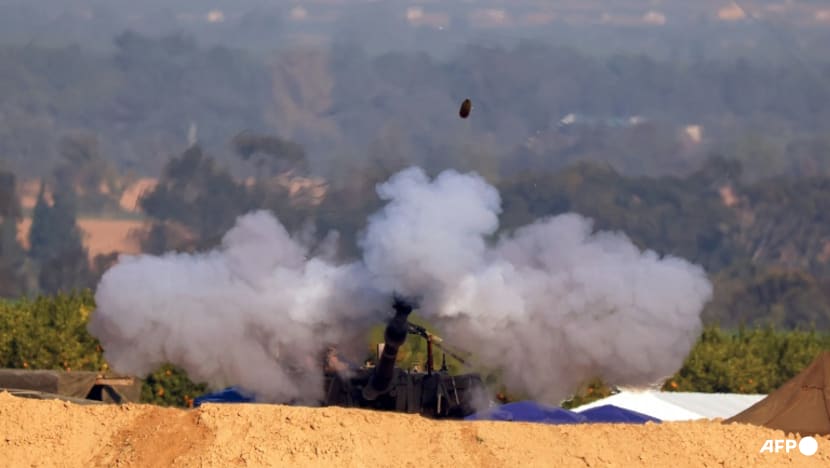Commentary: The Middle East is a tinderbox ready to explode
There is a risk that the multiple crises engulfing the Middle East will eventually become unmanageable and spin out of control, says international security expert Stefan Wolff.

An Israeli army self-propelled howitzer fires from southern Israel toward the Gaza Strip in the battle with Hamas militants (Photo: AFP/JACK GUEZ)

This audio is generated by an AI tool.
BIRMINGHAM, England: Ever since the attacks carried out by Hamas against Israel on Oct 7, 2023, and the subsequent Israeli retaliatory air and ground campaign, there have been fears that this latest confrontation between these two long-standing foes could escalate into a wider regional conflagration.
While this has not happened yet, the longer history of the Israeli-Palestinian and Arab-Israeli conflicts highlights potential for escalation.
With violence increasing across the wider Middle East, there are several potential pathways to escalation - via Iranian-sponsored terrorist groups, through worsening inter-state relations and by great powers being drawn into any of these conflicts.
INSTABILITY IN LEBANON
First, Iranian proxies could increase their activities more significantly, including in what they might regard as a show of solidarity with Palestinians in general, and with Hamas and Palestinian Islamic Jihad, both of which are also sponsored by Iran as part of the so-called Axis of Resistance.
In the case of Lebanon-based Hezbollah, this would open a second front in northern Israel. The situation there has been tense for months. Several flare-ups have brought this escalation scenario close to reality, including Israel’s targeted assassination of senior Hezbollah leaders in southern Lebanon.
The United States' efforts to calm the situation have only been moderately successful, and indirect channels of communication appear to remain open between Israel and Hezbollah. This is particularly important as a more intense direct confrontation between Israel and Hezbollah could trigger another full-scale war as it did in 2006 - a grim prospect given Lebanon’s protracted political volatility and economic instability.
STRIKES IN SYRIA, IRAQ, PAKISTAN FUEL HOSTILITIES
US support for Israel may have become more equivocal over the past several months, but Washington is still seen as Tel-Aviv’s most important backer. This has exposed US military bases across the Middle East to a significant increase in attacks and prompted counter-strikes by US forces. Similar tit-for-tat escalations have now engulfed several other states across the region and beyond.
Israel struck an Iran-linked target in the Syrian capital, Damascus, while Jordan carried out attacks against alleged drug smugglers in Syria.
Adding to concerns over stability in Syria as a whole, Iran sent ballistic missiles against alleged Islamic State targets in Syria, in retaliation for an IS attack in Iran’s city of Kerman on Jan 3.
The same reason was given for Iranian strikes against Erbil in northern Iraq, which also targeted an alleged Israeli spy facility there, prompting widespread condemnation because of the risk of further destabilisation of an already volatile Iraq.
And in yet another demonstration of Iranian assertiveness, Tehran carried out air strikes against a base of Jaish al-Adl, a terrorist group operating in the Iran-Pakistan border area. This prompted retaliatory strikes from Pakistan two days later.
None of these incidents have escalated into prolonged cross-border hostilities yet, indicating that political leaders are still able to show a minimum of restraint. At the same time, the pattern of attacks also demonstrates the pivotal role that Iran is playing in any potential further escalation.
FLASHPOINTS FROM THE ISRAEL-HAMAS WAR
This is nowhere more obvious than in the case of the attacks by Iran-backed Houthis in Yemen against shipping lanes in the Red Sea.
These attacks pose a major threat to the global economy with about 12 per cent of international trade and more than US$1 trillion worth of goods passing through the Red Sea each year.
To protect the around 17,000 ships annually making the journey through the Suez Canal, the US and UK have carried out several strikes against Houthi targets in Yemen.
This instability off the coast of Yemen has also affected China’s export-oriented economy, and while Beijing has framed the situation in the Red Sea as a direct consequence of the Israel-Hamas war, it did not veto a United Nations Security Council resolution strongly condemning Houthi attacks.
The crisis in the Red Sea, however, has potential to undermine efforts to end Yemen’s civil war, in which the country’s internationally recognised government, militarily backed by Saudi Arabia and the United Arab Emirates, has fought the Houthis since 2015.
Because Saudi Arabia and Iran back different sides in this conflict, any further escalation could also derail further China-brokered rapprochement between these two regional rivals.
This, in turn, also decreases the likelihood of a sustainable solution for the crisis in Gaza. Hamas receives most of its backing from Iran and Qatar and is also able to fund-raise in Qatar itself.
In contrast, most other Arab states are keen to see Hamas defeated in Gaza, regardless of their support for the Palestinian cause.
This hostility towards Iranian proxies is even more obvious in the case of Hezbollah: With both the political and military wings Hezbollah banned by all the members of the Gulf Co-operation Council and most other Arab countries in North Africa, there should be no illusion about the fact that Hezbollah is seen as a threat by rulers across the Arab world - a perception that extends to Iran as the main sponsor of Hamas, Hezbollah and a range of other terrorist groups.
Amid these complex calculations by political leaders across the Middle East and beyond, Palestinian suffering in Gaza continues at an unprecedented level.
With Israeli Prime Minister Benjamin Netanyahu again explicitly ruling out the creation of Palestinian state, a pathway towards a settlement that could be broadly supported across the region and at the UN, is nowhere in sight. Netanyahu’s dangerous stance also, and perhaps fatally, undermines prospects for the rapprochement between Saudi Arabia and Israel that would be critical for sustainable peace in the Middle East.
With the Israel-Hamas war unlikely to end soon, let alone any prospects of a sustainable solution to the wider Arab-Israeli and Israeli-Palestinian conflict, the risk of escalation is likely to remain high and turn into reality – if not by design, then by miscalculation as the multiple crises engulfing the Middle East will eventually become unmanageable and spin out of control.
Stefan Wolff is Professor of International Security at the University of Birmingham and Head of the Department of Political Science and International Studies.
















